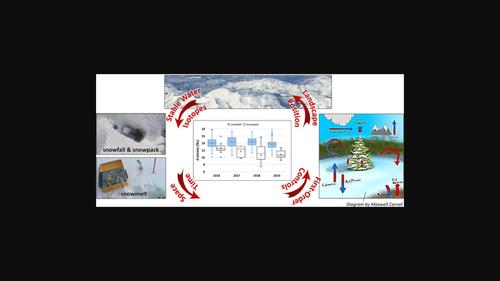当前位置:
X-MOL 学术
›
Hydrol. Process.
›
论文详情
Our official English website, www.x-mol.net, welcomes your
feedback! (Note: you will need to create a separate account there.)
Variability in observed stable water isotopes in snowpack across a mountainous watershed in Colorado
Hydrological Processes ( IF 2.8 ) Pub Date : 2022-07-26 , DOI: 10.1002/hyp.14653 Rosemary W. H. Carroll 1 , Jeffery Deems 2 , Reed Maxwell 3 , Matthias Sprenger 4 , Wendy Brown 5 , Alexander Newman 5 , Curtis Beutler 5 , Markus Bill 4 , Susan S. Hubbard 4 , Kenneth H. Williams 4
Hydrological Processes ( IF 2.8 ) Pub Date : 2022-07-26 , DOI: 10.1002/hyp.14653 Rosemary W. H. Carroll 1 , Jeffery Deems 2 , Reed Maxwell 3 , Matthias Sprenger 4 , Wendy Brown 5 , Alexander Newman 5 , Curtis Beutler 5 , Markus Bill 4 , Susan S. Hubbard 4 , Kenneth H. Williams 4
Affiliation

|
Isotopic information from 81 snowpits was collected over a 5-year period in a large, Colorado watershed. Data spans gradients in elevation, aspect, vegetation, and seasonal climate. They are combined with overlapping campaigns for water isotopes in precipitation and snowmelt, and a land-surface model for detailed estimates of snowfall and climate at sample locations. Snowfall isotopic inputs, describe the majority of δ18O snowpack variability. Aspect is a secondary control, with slightly more enriched conditions on east and north facing slopes. This is attributed to preservation of seasonally enriched snowfall and vapour loss in the early winter. Sublimation, expressed by decreases in snowpack d-excess in comparison to snowfall contributions, increases at low elevation and when seasonal temperature and solar radiation are high. At peak snow accumulation, post-depositional fractionation appears to occur in the top 25 ± 14% of the snowpack due to melt-freeze redistribution of lighter isotopes deeper into the snowpack and vapour loss to the atmosphere during intermittent periods of low relative humidity and high windspeed. Relative depth of fractionation increases when winter daytime temperatures are high and winter precipitation is low. Once isothermal, snowpack isotopic homogenization and enrichment was observed with initial snowmelt isotopically depleted in comparison to snowpack and enriching over time. The rate of δ18O increase (d-excess decrease) in snowmelt was 0.02‰ per day per 100-m elevation loss. Isotopic data suggests elevation dictates snowpack and snowmelt evolution by controlling early snow persistence (or absence), isotopic lapse rates in precipitation and the ratio of energy to snow availability. Hydrologic tracer studies using stable water isotopes in basins of large topographic relief will require adjustment for these elevational controls to properly constrain stream water sourcing from snowmelt.
中文翻译:

科罗拉多州山区流域积雪中观察到的稳定水同位素的变化
在 5 年的时间里,在科罗拉多州的一个大流域收集了 81 个雪坑的同位素信息。数据跨越海拔、坡向、植被和季节性气候的梯度。它们与降水和融雪中水同位素的重叠运动以及用于详细估计样本位置降雪和气候的地表模型相结合。降雪同位素输入,描述了大部分 δ 18O 积雪变化。Aspect 是次要控制,在朝东和朝北的斜坡上具有稍微丰富的条件。这归因于在初冬保存了季节性丰富的降雪和蒸汽损失。升华,表现为与降雪贡献相比积雪 d-过量的减少,在低海拔和季节性温度和太阳辐射高时增加。在积雪高峰期,由于在低相对湿度和高相对湿度间歇性期间较轻同位素重新分布到积雪中较深的同位素和蒸汽损失到大气中,因此在积雪的顶部 25 ± 14% 似乎发生了沉积后分馏。风速。当冬季白天温度高而冬季降水量低时,分馏的相对深度会增加。一旦等温,观察到积雪同位素均质化和富集,与积雪相比,初始融雪同位素耗尽,并随着时间的推移而富集。δ率每100米海拔损失,融雪中的18 O增加(d-过量减少)为每天0.02‰。同位素数据表明,海拔通过控制早期积雪持久性(或不存在)、降水中的同位素递减率以及能量与雪的可用性比率来决定积雪和融雪的演变。在大型地形起伏盆地中使用稳定水同位素的水文示踪研究将需要对这些高程控制进行调整,以适当限制融雪中的溪流水源。
更新日期:2022-07-26
中文翻译:

科罗拉多州山区流域积雪中观察到的稳定水同位素的变化
在 5 年的时间里,在科罗拉多州的一个大流域收集了 81 个雪坑的同位素信息。数据跨越海拔、坡向、植被和季节性气候的梯度。它们与降水和融雪中水同位素的重叠运动以及用于详细估计样本位置降雪和气候的地表模型相结合。降雪同位素输入,描述了大部分 δ 18O 积雪变化。Aspect 是次要控制,在朝东和朝北的斜坡上具有稍微丰富的条件。这归因于在初冬保存了季节性丰富的降雪和蒸汽损失。升华,表现为与降雪贡献相比积雪 d-过量的减少,在低海拔和季节性温度和太阳辐射高时增加。在积雪高峰期,由于在低相对湿度和高相对湿度间歇性期间较轻同位素重新分布到积雪中较深的同位素和蒸汽损失到大气中,因此在积雪的顶部 25 ± 14% 似乎发生了沉积后分馏。风速。当冬季白天温度高而冬季降水量低时,分馏的相对深度会增加。一旦等温,观察到积雪同位素均质化和富集,与积雪相比,初始融雪同位素耗尽,并随着时间的推移而富集。δ率每100米海拔损失,融雪中的18 O增加(d-过量减少)为每天0.02‰。同位素数据表明,海拔通过控制早期积雪持久性(或不存在)、降水中的同位素递减率以及能量与雪的可用性比率来决定积雪和融雪的演变。在大型地形起伏盆地中使用稳定水同位素的水文示踪研究将需要对这些高程控制进行调整,以适当限制融雪中的溪流水源。











































 京公网安备 11010802027423号
京公网安备 11010802027423号